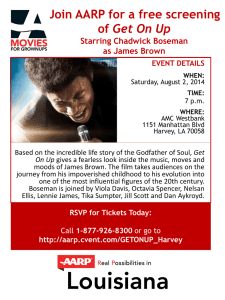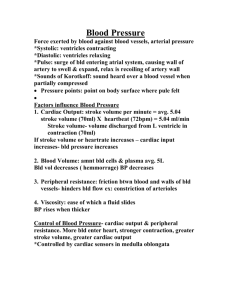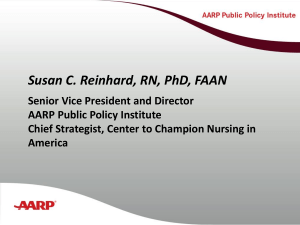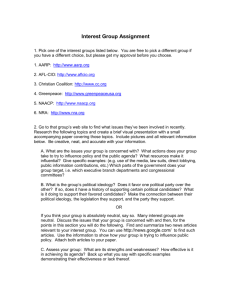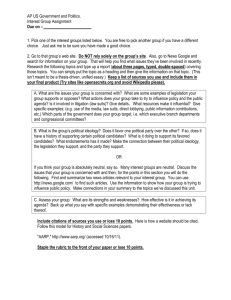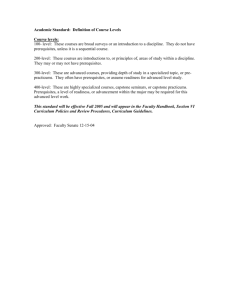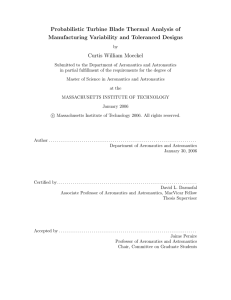AARP_UD_Update_IBS_Jan_2011_non-attendee-version
advertisement
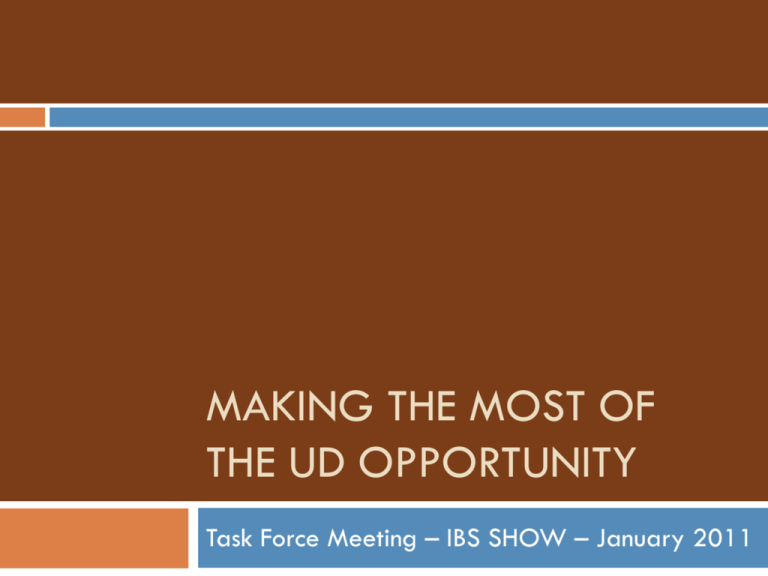
MAKING THE MOST OF THE UD OPPORTUNITY Task Force Meeting – IBS SHOW – January 2011 Today’s Discussion 2 Understanding UD Today The Consumer Mindset UD Around the World Barriers to UD The Opportunity to Create a Movement The Approach Working Models Staking our Claim Building Momentum What the Research Tells Us: Consumer Interest in and Adoption of Universal Design AARP Universal Design Consumer Education Task Force Orlando January, 2011 Jeanne Anthony, Sr. Project Manager AARP Education & Outreach 3 The Original Freedom House 4 The Freedom House AARP Survey: Home and Community Preferences of the 45+ Population September 2010 , What I’d Really Like to Do is Stay in My Current Residence for as Long as Possible (n=985) Somewhat disagree 4% Strongly disagree 5% Don't know 1% Neither agree nor disagree 4% Somewhat agree 13% Strongly agree 73% 7 AARP Survey: Home and Community Preferences of the 45+ Population September 2010, Household Features in Current Homes (n=985) A full bath on main level 82% A bedroom on main level 81% A sidewalk in front of home 64% A half bath on main level 43% An entrance without steps 36% Door handle levers instead of knobs 34% Doorways wider than standard 27% 0% 8 20% 40% 60% 80% 100% AARP Universal Design Research 9 1. Consumer understanding of Universal Design 10 2. Consumers identify the benefits associated with UD Pull-down shelving and Pot filler 11 3. Consumers lack vision to apply Universal Design to the design of homes 12 3. Consumers lack vision to apply Universal Design to the design of homes 13 4. Obstacles to consumer acceptance of Universal Design. 14 4. Obstacles to consumer acceptance of Universal Design 15 5. Obstacles to marketing of Universal Design to consumers 16 5. Obstacles to marketing of Universal Design to consumers 17 What to call Universal Design? Just Good Design Better Inclusive Home for All UNIVERSAL Universal Design Easy Living Design for All Home DESIGN Lifetime Design Just Good Design Home for All Easy UNIVERSAL DESIGN UNIVERSAL DESIGN Design for you Design for a Lifetime Good Home for All Good Design Inclusive Design Better Living Design Easy Living Adaptable Homes Design for All Home Adaptable Homes Good Design Smart Design 18 Today’s Discussion 19 Understanding UD Today The Consumer Mindset UD Around the World Barriers to UD The Opportunity to Create a Movement The Approach Working Models Staking our Claim Building Momentum 20 Understanding UD Today Getting from “Old, Frail and Disabled” to “Design Everything for Everyone” “Universal Design” has issues 21 Consumers don’t understand it, want it, or think it is ever going to be for them. Builders equate it with ADA requirements. Architects and Designers haven’t embraced it as “critical” (but they have embraced “green” as critical – and cool). There is not consensus as to what it could, should or must be. In theory it is a thing of beauty, in reality it simply isn’t much of anything. 22 The idea, though, can be communicated 23 The idea, though, can be communicated 24 The idea, though, can be communicated 25 The idea, though, can be communicated 26 But in the home, it means old, frail and disabled 27 The best UD is transparent (invisible) to consumers Which makes it much harder to communicate 28 Clearly there is work to be done We are miles from “design everything for everybody” 29 UNIVERSAL DESIGN AROUND THE WORLD 30 Common Threads Most are about “old, frail, disabled.” Government funding is apparent, if not key. There is some type of formal organization or association behind the effort. Some examples… Australia was going strong… 31 But seems to have been dormant since late 2009 Ireland has a program, too 32 Germany is investing, too 33 Japan is also a serious player 34 Japanese Corporations are involved 35 Every major Japanese corporation is a full dues paying member Norway will be UD by 2025 36 As dictated by the Ministry of Children and Equality New Zealand Leads the Way 37 Lifetime Design program is clear, simple, & working: It’s been embraced by developers 38 Five Basic Tenets: 39 1. 2. 3. 4. 5. Usable Adaptable Accessible Inclusive Lifetime Value Nowhere in their material to they use the term “universal design.” They use Lifetime Design. The materials are consumer-friendly 40 Our Conclusion: 41 The U.S. is simply behind Let’s take stock of where we are and what we can do about it. 42 AMONG TASK FORCE MEMBERS: UNIVERSAL AGREEMENT EXISTS Initial Interviews with Experts 43 Most of you sense that “the UD bus” is stuck on the side of the road and needs a new kick start. All agree that “UD” itself needs to be repackaged or rebranded to be more relevant to today’s consumer. All want to “get on” the UD “bus” – they think it has potential and want to be involved. You are also willing to have AARP drive the effort right now, to convene all the players. And you hope AARP will engage their members in some fashion. Two Options for Reaching Consumers 44 Consumer Pull Trade Push Prerequisites: Prerequisites: A leader An organized effort 15 second sound bite United industry Accepted name/term Big budget A convener An organizing effort A manifesto Industry representative Accepted name/term No budget Our Initial Approach 45 Consumer Pull Trade Push Prerequisites: Prerequisites: A leader An organized effort We started 15 second sound bitehere: United industry Accepted name/term Big budget A convener An organizing effort A manifesto Industry representative Accepted name/term No budget But Can We Do Both? 46 Consumer Pull Trade Push Prerequisites: Prerequisites: A leader An organized effort 15 second sound bite United industry Accepted name/term Big budget A convener An organizing effort A manifesto Industry representative Accepted name/term No budget Convening a Coalition 47 Five Key Principles of Effective Collaboratives: 1. A clear purpose, vision or mission. 2. A champion or convener/organizer. 3. A commitment to the time required to succeed. 4. The right processes and tools for collaboration. 5. Concrete deliverables and outcomes. And So Far, So Good 48 Five Key Principles of Effective Collaboratives: 1. A clear purpose, vision or mission. ✔ 2. A champion or convener/organizer. ✔ 3. A commitment to the time required to succeed. ✔ 4. The right processes and tools for collaboration. ✔ 5. Concrete deliverables and outcomes. ✔ 49 Our Singular Focus: Help Universal Design more quickly reach a “tipping point” with consumers But… Two Key Unresolved Issues 50 There isn’t agreement on the name/term. UD comes with much baggage to those in the home industry and doesn’t have much meaning with consumers. The effort needs a rallying point and can a name/term serve that? Should our focus begin in the home or not? There is bias for UD in the home that doesn’t appear when applied to products. Consumers have a difficult time making all the connections between UD and its benefits in their home. Consumers need to experience UD in the home to “get it.” More Importantly… 51 There is a sense that this effort is still too abstract. How do we make it more concrete? 52 IDEAS? Seizing the Opportunity 53 How to Best Lead this Initiative? What Decisions are Needed to Move Forward? What Strategies and Tactics Make Sense? Where can Funding Come From? The Government Foundations Corporations Can We Leverage AARP and its Army of 37 Million? 54 Are There Models We Can Follow? Engaging Consumers… Starting a Movement… 1. Good Housekeeping Seal of Approval 2. Energy Star 3. Lifetime Design/Lifemark 101 Years of Success 55 Official review and accreditation Requires payment to earn the badge While less meaningful today, still viable The Power of Energy Star 56 Driven by the EPA initially A trade push strategy Evolved now into a movement Lifemark Provides a Good Model 57 Clear, simple, & consumer-friendly. No mention of “universal design” anywhere. 58 ONE IDEA 59 Form a new Association It will have instant legitimacy based on the Organizing Members Organizing Members of Association 60 61 The Mission of the Association: Encourage more wide-spread interest and acceptance in a new standard for design as related to the home and products for the home. 62 Announce a New Name “Better Living Design” or BLD The new standard where everything is designed for everyone. “Better Living Design” 63 Incorporates the principles of UD, and/or sustainability and/or consumer-directed design. Applies to everything. Aspirational and attractive not only to designers, manufacturers, builders and developers, but to consumers as well. Not age-based or ADA specific. The “new standard” in product and housing design. Delivers emotional as well as rational benefits. Has a great acronym: BLD A Tactical Approach 64 1. Start the Better Living Design association 2. www.betterlivingdesign.org (already secured) Task Force members get free membership for next five years. Charge others to join to start to create a war chest. Announce the new association immediately and seek funding from Task Force members, the government and foundations. Identify initial BLD approved products and issue them certificates/seals. Include Heinz, Oxo, Target and others. Announce Iconic BLD Examples: 65 A Tactical Approach (continued) 66 3. Work with TF member associations to develop content, certification and or designations for BLD as applied to home design and building. 4. Rename CAPS and other “aging” or UD-focused programs with the BLD terminology. Work with Home Improvement retailers on BLD designation for products they sell – push up stream to manufacturers and downstream in-store to consumers. A Tactical Approach (continued) 67 5. Create a BLD presentation and education module for elementary, middle and high schools that AARP members can volunteer and conduct. 6. Turn loose an army of engaged members to reach children, who will then take the message home to mom, dad and grandparents. Develop awards and certification for Builders who embrace the BLD standard (follow the Lifemark model). Next Steps and Responsibilities 68
